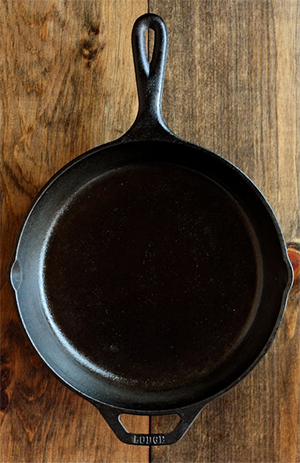How to Clean Season Cast Iron
CAUTION: Wear rubber gloves and eye protection while doing this!!
How to Clean Season Cast Iron. Begin by spraying the pan with oven cleaner and putting it in a plastic bag for a couple of days. The bag keeps the oven cleaner from drying out so it will continue to work. After a couple of days, remove it from the bag and scrub it in a solution of dish soap/water. I use a brass brush purchased at a super market, or my favorite, a brass brush I purchased at Rite Aid Pharmacy in their automotive counter. This brush is marketed for cleaning white wall tires. It is just the right size for doing pans. If all the burned on grease doesn’t come off, repeat the process, concentrating the cleaner to the areas not cleaned.
For bulk cleaning, you can prepare a soak of one and a half gallons of water to one 18 ounce can of lye in a plastic container. Lye like oven cleaner is very caustic and will burn you. Always wear rubber gloves. Mix enough in the plastic container to cover the items to be cleaned. Leave the pieces in the soak for about five days. Then scrub the piece. You can use the lye mixture several times. Do not use oven cleaner or lye on aluminum! It will eat the aluminum! Lye and oven cleaner will also eat the finish off wood handles and japanned pieces, and will dull porcelain finishes.
To remove rust, buff the pan with a fine wire wheel in an electric drill. Crusted rust can be dissolved by soaking the piece in a 50% solution of white vinegar and water for a few hours. Don’t leave it more than overnight without checking it. This solution will eventually eat the iron! It is now important to neutralize and stop the action of the vinegar. To neutralize the acid action of the vinegar again apply the oven cleaner and let the piece soak over night. You can also soak the piece over night in an alkaline solution such as washing soda which is available in the cleaning dept of most supermarkets and also some hardware stores. The washing soda neutralizes the vinegar so it will not continue to attack the iron. Then scrub the piece in dish detergent and hot water before seasoning.
After removing the burned on grease you are ready to season the piece. Preheat the oven to 125 degrees. This removes any moisture in the oven which could condense on the cold skillet leaving a very fine gold or rust color. Then preheat the pieces in the 125 degree oven for about 15 minutes or until they are hot. After the piece is heated remove it and apply shortening. I prefer solid Crisco. Some prefer lard or bacon grease. Oil does not work as well as these three. Apply solid Crisco; it flows right on. Of course you have to use a hot pad or rag to hold them. Return them to the oven right side up and raise the temperature to 225 degrees. Leave them for 1/2 hour then remove them and wipe any pooling of the shortening, leaving the piece still shining wet. The timing is important here because if you leave them in the oven to long the shortening begins to thicken. Put them back in the oven for another half hour. When you remove them this time let them cool down a bit, but are still hot, then wipe them to a dull shine. The initial seasoning should be accomplished at the point, However, typical of cast iron cookware, the more you use it (and don’t abuse it) the better it will be. It is generally recommended that you cook fatty foods in the pan as this adds to the seasoning process.
I DO NOT recommend the following methods of cleaning:
- Throw it in a fire – The intense heat of a fire can severely warp or even crack the piece.
- Self Cleaning Oven – Although not as great a risk as throwing it in a fire, the intense heat of a self cleaning can warp a skillet. There is also a risk of warping the piece.
- Sandblasting – This is the cardinal sin for collectors. Sand blasting destroys the patina making the piece a dull gray color. Most collectors will not buy a piece that has been sand blasted.
After cooking in the pan, DO NOT use a detergent to clean it. That will destroy the seasoning. Put hot water in the pan and bring it to a boil. CAUTION: Do not put cold water in a hot pan! Let the pan soak for several minutes, then wipe it out with a paper towel. If something sticks, scrape it with a spoon to dislodge it. Do not use a brillo pad to scour it! An abrasive pad cuts into the seasoned surface. Then, reheat the pan and apply a fine coating of shorting, oil, or Pam. Do not apply enough to run. Just enough to wet the surface with a fine layer.

